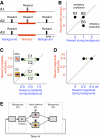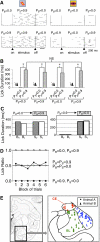Responses of amygdala neurons to positive reward-predicting stimuli depend on background reward (contingency) rather than stimulus-reward pairing (contiguity)
- PMID: 20032233
- PMCID: PMC2887637
- DOI: 10.1152/jn.00933.2009
Responses of amygdala neurons to positive reward-predicting stimuli depend on background reward (contingency) rather than stimulus-reward pairing (contiguity)
Abstract
Prediction about outcomes constitutes a basic mechanism underlying informed economic decision making. A stimulus constitutes a reward predictor when it provides more information about the reward than the environmental background. Reward prediction can be manipulated in two ways, by varying the reward paired with the stimulus, as done traditionally in neurophysiological studies, and by varying the background reward while holding stimulus-reward pairing constant. Neuronal mechanisms involved in reward prediction should also be sensitive to changes in background reward independently of stimulus-reward pairing. We tested this assumption on a major brain structure involved in reward processing, the central and basolateral amygdala. In a 2 x 2 design, we examined the influence of rewarded and unrewarded backgrounds on neuronal responses to rewarded and unrewarded visual stimuli. Indeed, responses to the unchanged rewarded stimulus depended crucially on background reward in a population of amygdala neurons. Elevating background reward to the level of the rewarded stimulus extinguished these responses, and lowering background reward again reinstated the responses without changes in stimulus-reward pairing. None of these neurons responded specifically to an inhibitory stimulus predicting less reward compared with background (negative contingency). A smaller group of amygdala neurons maintained stimulus responses irrespective of background reward, possibly reflecting stimulus-reward pairing or visual sensory processes without reward prediction. Thus in being sensitive to background reward, the responses of a population of amygdala neurons to phasic stimuli appeared to follow the full criteria for excitatory reward prediction (positive contingency) rather than reflecting simple stimulus-reward pairing (contiguity).
Figures









Similar articles
-
Neuronal signals in the monkey basolateral amygdala during reward schedules.J Neurosci. 2005 Nov 30;25(48):11071-83. doi: 10.1523/JNEUROSCI.1796-05.2005. J Neurosci. 2005. PMID: 16319307 Free PMC article.
-
Neuronal responses of the rat amygdala during extinction and reassociation learning in elementary and configural associative tasks.Eur J Neurosci. 2002 Feb;15(4):753-68. doi: 10.1046/j.1460-9568.2002.01889.x. Eur J Neurosci. 2002. PMID: 11886454
-
Dissociable neural effects of long-term stimulus-reward pairing in macaque visual cortex.J Cogn Neurosci. 2010 Jul;22(7):1425-39. doi: 10.1162/jocn.2009.21288. J Cogn Neurosci. 2010. PMID: 19580385
-
Functions of primate amygdala neurons in economic decisions and social decision simulation.Behav Brain Res. 2021 Jul 9;409:113318. doi: 10.1016/j.bbr.2021.113318. Epub 2021 Apr 24. Behav Brain Res. 2021. PMID: 33901436 Free PMC article. Review.
-
Predictive reward signal of dopamine neurons.J Neurophysiol. 1998 Jul;80(1):1-27. doi: 10.1152/jn.1998.80.1.1. J Neurophysiol. 1998. PMID: 9658025 Review.
Cited by
-
Amygdala connectivity and implications for social cognition and disorders.Handb Clin Neurol. 2022;187:381-403. doi: 10.1016/B978-0-12-823493-8.00017-1. Handb Clin Neurol. 2022. PMID: 35964984 Free PMC article. Review.
-
Prediction suppression in monkey inferotemporal cortex depends on the conditional probability between images.J Neurophysiol. 2016 Jan 1;115(1):355-62. doi: 10.1152/jn.00091.2015. Epub 2015 Nov 18. J Neurophysiol. 2016. PMID: 26581864 Free PMC article.
-
Evaluation of ambiguous associations in the amygdala by learning the structure of the environment.Nat Neurosci. 2016 Jul;19(7):965-72. doi: 10.1038/nn.4308. Epub 2016 May 23. Nat Neurosci. 2016. PMID: 27214568 Free PMC article.
-
Pavlovian learning and conditioned reinforcement.J Appl Behav Anal. 2023 Jun;56(3):498-519. doi: 10.1002/jaba.1004. Epub 2023 May 31. J Appl Behav Anal. 2023. PMID: 37254881 Free PMC article.
-
Different time courses for learning-related changes in amygdala and orbitofrontal cortex.Neuron. 2011 Sep 22;71(6):1127-40. doi: 10.1016/j.neuron.2011.07.016. Epub 2011 Sep 21. Neuron. 2011. PMID: 21943608 Free PMC article.
References
-
- Aggleton JP, Passingham RE. Stereotaxic surgery under X-ray guidance in the rhesus monkey, with special reference to the amygdala. Exp Brain Res 44: 271–276, 1981 - PubMed
-
- Baker AG. Conditioned inhibition arising from a between-sessions negative correlation. J Exp Psychol 3: 144–155, 1977
-
- Balsam PD, Fairhurst S, Gallistel CR. Pavlovian contingencies and temporal information. J Exp Psychol Anim Behav Proc 32: 284–294, 2006 - PubMed
Publication types
MeSH terms
Grants and funding
LinkOut - more resources
Full Text Sources

